![]()
![]()
![]()
Use LEFT and RIGHT arrow keys to navigate between flashcards;
Use UP and DOWN arrow keys to flip the card;
H to show hint;
A reads text to speech;
36 Cards in this Set
- Front
- Back
|
Sponges Characteristics
|
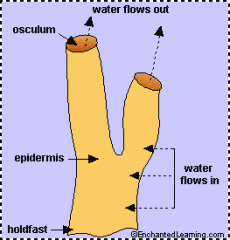
a) Suspension feeder: captures food particles suspended in water that pass through it; non-motile
b) Asymmetric c) Lack true tissue d) Size= few mm – few m |
|
|
Sponge anatomy
|
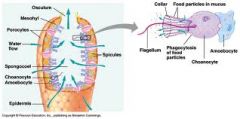
a) Spongocoel (sponge space): central cavity of sponges
b) Osculum (opening of sponge): larger opening in sponges c) Mesophyll (middle layer): middle, gelatinous layer between exterior and interior cells d) Choanocytes (sperm): flagellated cells lining the interior of the sponge; generate current for filter feeding e) Amoebocytes (amoeba): cells in the mesophyll that move about by pseudopodia; ingest/digest food, produce spicules |
|
|
Sponge reproduction
|
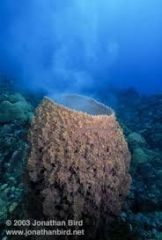
a) Hermaphrodite: each sponge functions as both sexes during reproduction
b) Sequential hermaphroditism: sponge functions first as one sex, then the other |
|
|
Cnidarian characteristics
|

a) Carnivorous, sessile & free-floating
b) Radial symmetric c) True tissues d) Size = few mm – few m |
|
|
Cnidarian anatomy:Poly p
|
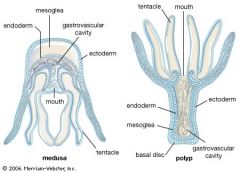
Poly p: cylindrical forms that adhere to substrate with mouths and arms up
Example: sea anemones |
|
|
Cnidarian anatomy:Medusa
|
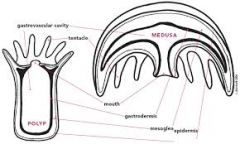
flattened, free-swimming froms with mouths and arms down
Example: jelly fish |
|
|
Cnidarian anatomy: Cnidocytes
|
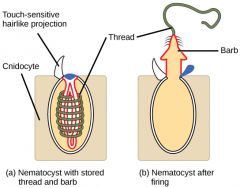
cells designed for defense and prey capture – located on tentacles
|
|
|
Cnidarian anatomy: Nematocysts
|
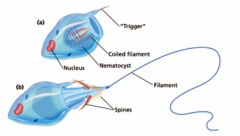
stinging capsules
Nerve net: no brain based around sensory structures throughout body controlling contractile tissues |
|
|
Cnidarian anatomy: Gastrovascular cavity
|
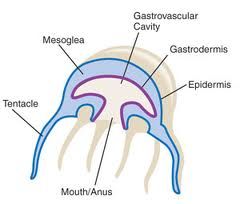
acts as a hydrostatic skeleton for shape
|
|
|
Platyhelminthes (flatworm) characteristics
|

a) Free living and parasitic
b) Dorsoventrally flattened c) Marine, freshwater inhabitants d) Microscopic – 20 m long |
|
|
Platyhelminthes (flatworm) anatomy
|
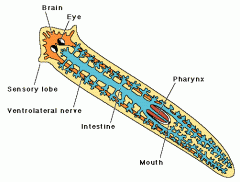
a) Triploblastic
b) Acoelomates c) Sinlge-opening gastrovascular cavity d) Gas exchange, waste elimination by diffusion |
|
|
Flatworm Diversity: Turbellarians
|

i. Free living predatory & saprophytic
ii. Ciliated movement on a film of mucus iii. Light-senstive eyes, chem-sensitive ears iv. Asexual/sexual reproduction |
|
|
Flatworm Diversity: Tapeworms
|
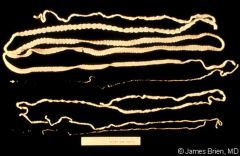
i. Parasitic on vertebrates
ii. Hermaphroditic – gonas in proglottids iii. Scolex with suckers/hooks for attachment iv. No gastrovascular cavity – nutrition by absorption |
|
|
Rotifer characteristics
|
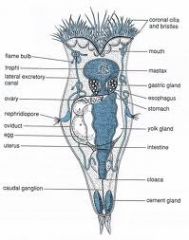
a) Crown of cilia creates vortex of water for feeding where pharyngeal grind up food
b) Alimentary canal with mouth and anus c) Marine, freshwater inhabitants d) 5 – 2.0 mm in length |
|
|
Rotifer reproduction
|
a) Parthenogenesis: reproduction in which offspring develop from unfertilized eggs
b) All female c) Bdelloidea – became asexual 35 mya |
|
|
Mollusca characteristics
|

a) Soft – bodied animals, most protected by a shell of calcium
b) Marine, freshwater, terrestrial c) Includes snail, slugs, oysters, clams, octopuses, and squid |
|
|
Mollusca reproduction
|
a) Most have separate exes with gonads
b) Many snails are hermaphroditic c) Larval stage of many marine mollusks include a trochophore and veliger |
|
|
Mollusca diversity: Gastropods
|

(75% of mollusks spp)
a) Marin, freshwater, terrestrial b) Most with a shell and distinct head c) Herbivores and carnivores |
|
|
Mollusca diversity: Bivalves
|
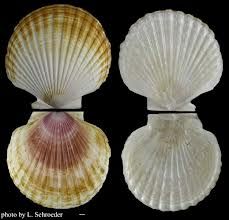
a) Marine and freshwater
b) Hinged shells, no distinct head c) Sessile filter-feeders |
|
|
Mollusca diversity: Cephalopods
|
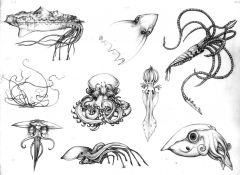
a) Closed circulatory system
b) Shell reduced or missing c) Well-developed sense organs with a complex brain active predators d) Tentacles containing suckers/teeth are used to grasp prey and immobilizing is injected with a break-like jaw e) Ammonite |
|
|
Ammonite:
|
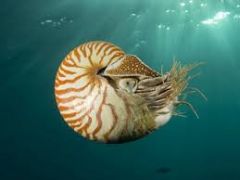
dominant marine invertebrate predator for hundreds of millions of years up to 1 m in diam.; disappeared at the end of cretaceous 65 mya.
|
|
|
Annelida characteristics
|
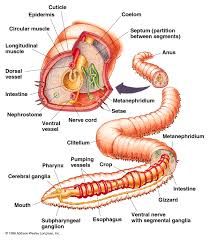
a) Segmented worms
b) Marine, freshwater, terrestrial c) 1mm – 3.0 m in length |
|
|
Annelida diversity: Oligochaetes
|

(earth worms)
i. Chaetae: ventral bristles made of chitin ii. Hermaphroditic iii. Ingest soil and extract nutrients iv. Clitellum: secretes mucous cocoon that slides along the worm picking up eggs and sperm, depositing it in soil. |
|
|
Annelida diversity:Polychaetes
|

(sand worms)
i. Each segment has a pair of parapodia that generally function in locomotion ii. Each parapodium has several chaetae – more numerous than in oligochaetes iii. Mostly marine – planktonic, pelagic, crawlers, burrowers, tube dwellers |
|
|
Annelida Diversity: Hirudineans
|

(leeches)
i. Predatory & parasitic ii. Blade-like teeth/ enzymes break skin iii. Anesthetic/anticoagulant secreted iv. Engorges itself on blood up to 10x own weight, but won’t eat again for months |
|
|
Round worms characteristics
|
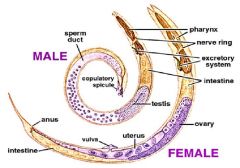
a) No circulatory system
b) Body covered by a cuticle, long muslces c) Aquatic/soil inhabitants as well as soft tissues of plants and animals d) 1 mm – 1.0 m in length e) 25,000 spp |
|
|
Roundworms reproduction
|
a) Sexual with separate sexes
b) Females lay 100,000+ eggs/day which are resistant to harsh conditions c) Most widespread of all spp |
|
|
Arthropoda anatomy
|
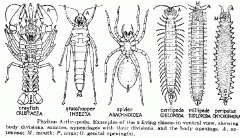
a) Exoskeleton made of chitin
i. Thick over body for protection, thin over joints of articulation ii. Allows for muscle attachment iii. Undergoes occasional molst iv. Impermeable to water, preventing dehydration b) Well developed sensory organs c) Open circulatory system: heart pumping hemolymph through short arteries into sinuses, reentering the heart via pores d) Gas echange carried out by gills in aquatic spp and tracheal systems in terrestrial spp |
|
|
Anthropoda diversity: Insects general information
|
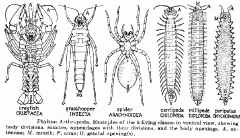
i. More spp than all other form of life combined
ii. Marine, freshwater and terrestrial inhabitants iii. First emerged 416 mya |
|
|
Anthropoda diversity: Insects reproduction
|
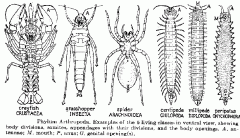
i. Usually sexual with separate sexes
ii. Internal fertilization; sperm is stored in the female for fertilizing one batch of eggs iii. Many insects mate only one in lifetime iv. Complete metamorphosis: larva stage, specialized for feeding, looks entirely different form adult, which is specialized for dispersal and breeding v. Incomplete metamorphosis: young resemble adults, but have different body proportions and lack wings vi. Reaches adult stage through population. Example: butterflies vii. Grows through a series of molts; with final molt becomes a winged, sexually mature adult. Ex: bugs |
|
|
Anthropoda Diversity: Crustaceans
|
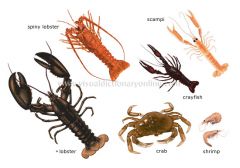
i. Marine, freshwater and terrestrial inhabitants
ii. Gas exchange occurs in thin parts of the cuticle or through gills iii. Specialized appendages |
|
|
Anthropoda Diversity: Crustaceans reproduction
|
i. Separate sexes
ii. Specialized appendages transfer sperm from male to female iii. Most aquatic crustaceans go through on or more swimming larval stages |
|
|
Echinoderms characteristics
|
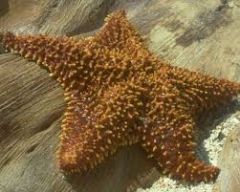
a) Spiny skin covering an endoskeleton of hard calcareous plates
b) Slow-moving or sessile marine spp c) Water vascular system that function in locomotion, feeding & temp. regulation |
|
|
Echinoderms reproduction
|
a) Separate sexes
b) External fertilization c) Pentamorous radial symmetry in adults; bilateral symmetry in larvae |
|
|
Chelicerae
|

claw like feeding appendages
|
|
|
Lophophores
|
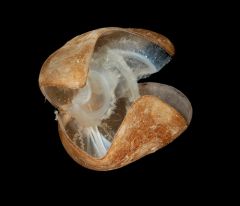
horse-shoe to circular crown of ciliated oral tentacles
|

